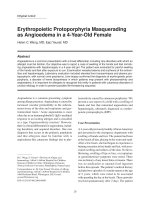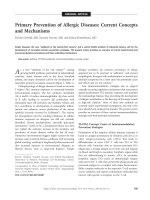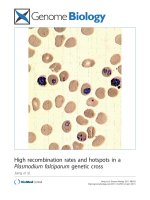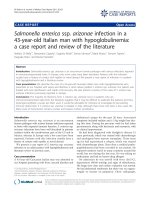Báo cáo y học: "Secondary prevention of allergic symptoms in a dairy farmer by use of a milking robot" ppsx
Bạn đang xem bản rút gọn của tài liệu. Xem và tải ngay bản đầy đủ của tài liệu tại đây (563.58 KB, 4 trang )
BioMed Central
Page 1 of 4
(page number not for citation purposes)
Clinical and Molecular Allergy
Open Access
Case Report
Secondary prevention of allergic symptoms in a dairy farmer by use
of a milking robot
Gintautas Korinth*
1
, Horst Christoph Broding
1
, Wolfgang Uter
2
and
Hans Drexler
1
Address:
1
Institute and Outpatient Clinic of Occupational, Social and Environmental Medicine, University Erlangen-Nuremberg, Schillerstrasse
25/29, D-91054 Erlangen, Germany and
2
Department of Medical Informatics, Biometry and Epidemiology, University Erlangen-Nuremberg,
Waldstrasse 6, D-91054 Erlangen, Germany
Email: Gintautas Korinth* - ; Horst Christoph Broding - ;
Wolfgang Uter - ; Hans Drexler -
* Corresponding author
Abstract
Background: Animal-derived allergens include lipocalins which play an increasing role in
occupational respiratory sensitizations. The prevention of sensitization in stock farming is often
difficult due to intense exposure, with traditional milking still requiring close animal contact.
Complete avoidance of allergen exposure is only possible if stock farming is abandoned. This is,
however, often not feasible in small dairy plants because of the resulting loss of income.
Case presentation: In a 37-year-old female farmer daily asthmatic complaints appeared,
associated with cow dust-derived allergen exposure by milking with a conventional device.
Respiratory symptoms increased during a period of 12 years. Allergic bronchial asthma was
diagnosed, caused by sensitization against cow dust-derived allergens, as demonstrated by positive
skin prick test and by detection of IgE antibodies. In a separate specific inhalation challenge test
using a 10% extract of cow dust-derived allergens a 330% increase of airway resistance was
detected. To enable further dairy farming, a milking robot was installed in 1999, i.e., an automatic
milking system. The novel milking technique reduced the daily exposure from over 2 hours to
approximately 10 min. The clinical course after the installation of the milking robot was favourable,
with less frequent allergic and asthmatic symptoms. Furthermore, asthma medication could be
reduced. Improvement was noted also in terms of lung-function and decreased total serum IgE.
Conclusion: The case presented and the evidence from the literature indicates that the strategy
of exposure minimization to allergens at workplaces can be an effective alternative to total
elimination. In farmers with cow dust allergy a milking robot is an appropriate technical measure
to minimize allergen-exposure.
Background
Allergic asthma ranks in Germany among frequent
occurred occupational diseases. Cow hair allergy in Fin-
land is one of the most frequent reasons for the develop-
ment of occupational asthma [1], but epidemiologically
in Germany still insufficiently explored. The prevalence of
respiratory complaints in Finnish farmers with cow hus-
bandry is 27% for rhinitis respectively 12% for asthma in
Published: 22 June 2005
Clinical and Molecular Allergy 2005, 3:8 doi:10.1186/1476-7961-3-8
Received: 26 August 2004
Accepted: 22 June 2005
This article is available from: />© 2005 Korinth et al; licensee BioMed Central Ltd.
This is an Open Access article distributed under the terms of the Creative Commons Attribution License ( />),
which permits unrestricted use, distribution, and reproduction in any medium, provided the original work is properly cited.
Clinical and Molecular Allergy 2005, 3:8 />Page 2 of 4
(page number not for citation purposes)
consequence of occupational exposure [2,3]. Until now
there is only limited insight into the risk factors with
regard to this disease. The prevention of sensitization in
stock farming to cow hair and epithelial allergens includ-
ing lipocalins is often difficult due to intense exposure,
with traditional milking still requiring close animal
contact.
The German Professionals insurance laws require a com-
plete elimination of allergens for the recognition of an
allergic airway disease as a compensable occupational dis-
ease. Complete avoidance of occupational exposure of
cow hair allergens is only possible if stock farming is
abandoned. This is, however, often not feasible in small
dairy plants because of the resulting loss of income.
In the present case report we discuss the efficiency of the
strategy of exposure minimization to allergens by the use
of a milking robot, i.e., an automatic milking system
(AMS) as an alternative measure to total elimination of
allergens for the prevention of occupational asthma
caused by cow hair allergy.
Case presentation and discussion
A 37-year-old female farmer reported to suffer from daily
asthmatic complaints by milking of cows with a conven-
tional device. Exposure associated respiratory symptoms
increased continuously during a period of 12 years. Aller-
gic bronchial asthma, caused by sensitization against cow
dust-derived allergens, was diagnosed by a positive skin
prick test (Bencard
®
) and by the detection of IgE antibod-
ies against Bos d 2 at 74.9 kIU/l (Pharmacia, UniCAP
®
).
Moreover, nonspecific bronchial hyperresponsiveness
was verified by a positive histamine inhalation challenge
test. The diagnosis of occupational asthma was confirmed
by a separate specific inhalation challenge test using a
10% extract of cow hair allergens which led to a 330%
increase of airway resistance (Raw).
The German Professionals insurance laws require com-
plete elimination of allergen exposures for the compensa-
tion of occupational allergic asthma as occupational
disease [4]. Legal consequence would usually be to aban-
don dairy farming. However, in our case presented, dairy
farming substantially contributed to family-income and
the compensation offered would be insufficient for sub-
sistence. Hyposensitization is the most effective measure
in the prevention of allergic symptoms in patients with
asthma. In that farmer the hyposensitization was not fea-
sible due to permanent exposure to allergens. This farmer
did not wear a helmet during the milking process because
of claustrophobic panic attacks (fear of suffocation).
Moreover an immunotherapy with recombinant lipoca-
lins is currently not available.
Respirator helmets have been predominantly used as
effective measures for prevention of the inhalation of
fumes and dusts [5]. Investigations about the effectiveness
of respirator helmets against high-molecular allergens to
prevent allergic asthma are rare. Taivainen et al. (1998)
demonstrated that due to the use of a dust respirator hel-
met with a P2-class filter, dairy farmers with occupational
asthma induced by cow dander showed less rhinitic symp-
toms and an improved peak flow rate [6]. However, work-
ers using respirator helmets were not prevented against a
progressive behavior of occupational asthma [7,8]. Thus it
is to doubt whether respirator helmets are efficient in
farmers with occupational asthma to provide a complete
protection against allergens [9].
To enable further dairy farming, the farmer installed a
milking robot in 1999, i.e., an automatic milking system
(AMS). At present circa 1300 AMS are installed, predomi-
nantly in the Netherlands, followed by Germany. AMS
were developed in the course of increasing automation of
the agricultural production. AMS consist of a milking box
with the milking equipment and an electronic controlling
system, an automatically operating dosing unit of a spe-
cific food-concentrate as well as a software controlled
management system. The cows are decoyed from a spe-
cific food-concentrate to enter the milking box. A trans-
ponder, fixed on the cow neck, initiates milking
operations automatically controlled by software and laser.
The milking robot operates in the cowshed, which is air-
shielded from the control-centre. After the installation of
AMS the farmer was involved only in terms of monitoring
the milking process. Figure 1 shows the job and the cur-
rent exposure situation of the farmer. It is apparent that
the novel milking technique reduced exposure signifi-
cantly by some 90% (from over 2 hours to approx. 10
min.) without a decline of milk production. Beyond aller-
gen exposure reduction, the physical workload was less-
ened and the time available for activities to improve
coping was increased – these factors are increasingly rec-
ognized as relevant for the prognosis of asthma [10].
Table 1 shows the influence of the AMS technique on the
current occupational exposure of the farmer. According to
German Professionals insurance laws all conceivable
measures must be taken into account even AMS is an
expensive technical device to prevent occupational
asthma.
After installation of the milking robot the farmer reported
significantly less frequent allergic and asthmatic symp-
toms. Asthma medication was reduced and required only
once daily in the evening. Improvement was noted also in
terms of lung-function and decreased total serum IgE:
serum IgE decreased from 1332 IU/ml before milking
robot installation to 572 and 474 IU/ml two and three
years after installation, respectively. FEV
1
improved by
Clinical and Molecular Allergy 2005, 3:8 />Page 3 of 4
(page number not for citation purposes)
20% and vital capacity by 11%, comparing values one
year before with two years after installation. A CAP-RAST
score "5" versus Bos d 2 was determined after the interven-
tion. Preceding EAST-Test results vs. Bos d 2 were not suit-
able for comparison.
Current discussions address threshold limit values for
allergens that may prevent allergic symptoms [11]. These
have been proposed also for the cow dust-derived allergen
Bos d 2 [12]. Table 2 shows examples for successful meas-
ures of exposure minimization at workplaces to reduce
Milking process monitoring by an air-shielded control-centreFigure 1
Milking process monitoring by an air-shielded control-centre.
Table 1: Parameters influenced by automatic milking system (AMS)
Parameter Power of parameter Influence of AMS
Daily exposure period ↓↓↓ Drop of more than 2 hours to approx. 10 min.
(> 90%)
Exposure intensity ↓↓↓ Increasing space to cow
Physical workload ↓↓ Monitoring tasks
Timing flexibility ↑↑ • No commitment to fixed milking times
• Free working plan
Quality of life ↑ More time available for other activities
Explanation: ↓ = reduction of power, ↑ = improvement of power
Clinical and Molecular Allergy 2005, 3:8 />Page 4 of 4
(page number not for citation purposes)
sensitizations. Recent studies have already demonstrated
that allergen exposure reduction at workplaces is success-
ful in reducing sensitizations, e.g., to latex proteins
[13,14], laboratory animals [15] or acid anhydrides [16].
Conclusion
The case presented and the evidence obtained from the lit-
erature indicates that the strategy of exposure minimiza-
tion to allergens at workplaces can be an effective
alternative to total elimination, which may not be feasible
for economical reasons. In farmers with cow dust allergy
a milking robot is an appropriate technical measure to
minimize allergen-exposure particularly with regard to
the reduced animal contact. Independently from this,
such milking robots also increasingly used to enhance
productivity (usually in herds comprising more than 50
animals). The efficacy of milking robots in terms of pri-
mary and secondary prevention should be evaluated also
epidemiologically in a suitable cohort study, preferably in
countries with intensive dairy farming.
List of abbreviation
AMS; Automatic milking system
Competing interests
The author(s) declare that they have no competing
interests.
Authors' contributions
GK was the principal investigator. GK examined the
patient, performed the investigations and drafted the
manuscript. HCB revised the manuscript. WU revised the
manuscript and evaluated the epidemiological aspects.
HD conceived the case report. All authors read and
approved the final manuscript.
References
1. Ylönen J, Mäntyjärvi R, Taivainen A, Virtanen T: IgG and IgE anti-
body responses to cow dander and urine in farmers with
cow-induced asthma. Clin Exp Allergy 1992, 22:83-90.
2. Virtanen T, Vilhunen P, Husman K, Happonen P, Mäntyjärvi R: Level
of airborne bovine epithelial antigen in Finnish cowsheds. Int
Arch Occup Environ Health 1988, 60:355-360.
3. Virtanen T, Vilhunen P, Husman K, Happonen P, Mäntyjärvi R: Sensi-
tization of dairy farmers to bovine antigens and effects of
exposure on specific IgG and IgE titers. Int Arch Allergy Appl
Immunol 1988, 87:171-177.
4. Merget R, Schultze-Werninghaus G: Occupational asthma: defini-
tion – epidemiology – etiologic substances – prognosis – pre-
vention – diagnosis – expert assessment aspects [in
German]. Pneumologie 1996, 50:356-363.
5. Kongerud J, Rambjor O: The influence of the helmet respirator
on peak flow rate in aluminum potroom. Am Ind Hyg Assoc J
1991, 52:243-248.
6. Taivainen AI, Tukiainen HO, Terho EO, Husman KR: Powered dust
respirator helmets in the prevention of occupational asthma
among farmers. Scand J Work Environ Health 1998, 24:503-507.
7. Slovak AJ, Orr RG, Teasdale EL: Efficacy of the helmet respirator
in occupational asthma due to laboratory animal allergy
(LAA). Am Ind Hyg Assoc J 1985, 46:411-415.
8. Cote J, Kennedy S, Chan-Yeung M: Outcome of patients with
cedar asthma with continuous exposure. Am Rev Respir Dis
1990, 141:373-376.
9. Müller-Wening D, Neuhauss M: Protective effect of respiratory
devices in farmers with occupational asthma. Eur Respir J 1998,
12:569-572.
10. Bergmann KC, Fischer J, Schmitz M, Petermann F, Petro W: Inpa-
tient pneumologic rehabilitation of adults: goals – diagnostic
and therapeutic standards – research needs [in German].
Pneumologie 1997, 51:523-532.
11. Baur X: Are we closer to developing threshold limit values for
allergens in the workplace? Ann Allergy Asthma Immunol 2003,
90:11-18.
12. Zeiler T, Taivainen A, Mäntyjärvi R, Tukiainen H, Rautiainen J,
Rytkönen-Nissinen M, Virtanen T: Threshold levels of purified
natural Bos d 2 for inducing bronchial airway response in
asthmatic patients. Clin Exp Allergy 2002, 32:1454-1460.
13. Edelstam G, Arvanius L, Karlsson G: Glove powder in the hospital
environment – consequences for healthcare workers. Int Arch
Occup Environ Health 2002, 75:267-271.
14. Tarlo SM, Sussman G, Contala A, Swanson MC: Control of air-
borne latex by use of powder-free latex gloves. J Allergy Clin
Immunol 1994, 93:985-989.
15. Thulin H, Björkdahl M, Karlsson AS, Renström A: Reduction of
exposure to laboratory animal allergens in a research
laboratory. Ann Occup Hyg 2002, 46:61-68.
16. Drexler H, Schaller KH, Nielsen J, Weber A, Weihrauch M, Welinder
H, Skerfving S: Efficacy of measures of hygiene in workers sen-
sitised to acid anhydrides and the influence of selection bias
on the results. Occup Environ Med 1999, 56:202-205.
Table 2: Examples for successful measures of exposure minimization at workplaces in reducing of sensitizations
Exposure areas Allergen Measure of exposure
minimization
Study
Hospitals Latex proteins Replacement of powdered gloves
through powder-free gloves
Edelstam et al. 2002, Tarlo et al.
1994
Animal research laboratories Allergens to laboratory animals Technical improvement of housing
cabinets for animals
Thulin et al. 2002
Electrical industry Acid anhydrides Installation of a closed system in
the production of epoxy resin
Drexler et al. 1999









